Ecuador Tourism And Attractions are diverse, offering something for every traveler. SIXT.VN provides tailored travel advice, convenient airport transfers, and hotel booking services, making your exploration of Ecuador seamless and unforgettable. From the Galapagos Islands to the Andes Mountains, discover Ecuador’s must-see destinations, utilizing SIXT.VN for stress-free travel planning.
1. Discovering the Enchanting Galápagos Islands
Are the Galápagos Islands on your bucket list? Absolutely, the Galápagos Islands are a must-see destination for their unique wildlife and volcanic landscapes. Named after the giant tortoises inhabiting the islands, this UNESCO World Heritage Site offers an unparalleled opportunity for wildlife viewing, thanks to its unique ecosystem that evolved in isolation. As one of the most active volcanic regions globally, the Galápagos continue to evolve, featuring 13 major islands, six smaller islands, and 42 islets, most of which are protected within the Galápagos National Park since the 1950s.
Visiting this delicate ecosystem requires joining a guided tour to authorized sites, though some areas are accessible without a guide, including popular scuba diving spots. The islands are famed for their endemic bird species, including the Galápagos penguin, flightless cormorant, waved albatross, and Darwin’s finches.
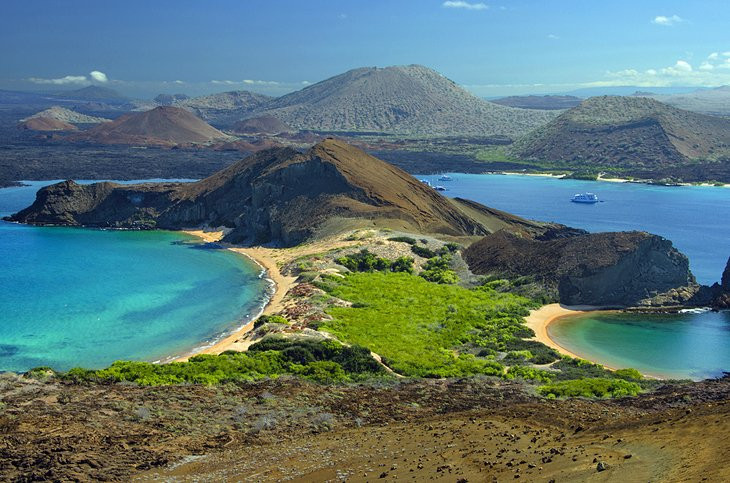 Bartolome Island, Galápagos
Bartolome Island, Galápagos
Ensure you plan a visit to the Charles Darwin Research Station in Puerto Ayora on Santa Cruz Island for an insightful behind-the-scenes experience. According to research from the Charles Darwin Foundation in 2023, guided tours significantly enhance visitors’ understanding of the islands’ ecology and conservation efforts. SIXT.VN can assist in arranging these tours as part of a comprehensive travel package.
2. Exploring Quito: Ecuador’s Historic Andean Capital
Why should Quito be on your Ecuador itinerary? Quito should be on your Ecuador itinerary because it is rich colonial history and stunning Andean setting. Nestled high in the Andes, Ecuador’s capital, Quito, is a UNESCO World Heritage site boasting well-preserved colonial architecture. As South America’s largest historic center, Quito attracts artisans and shoppers alike with its vibrant local art and crafts scene, ranging from ceramics to colorful clothing.
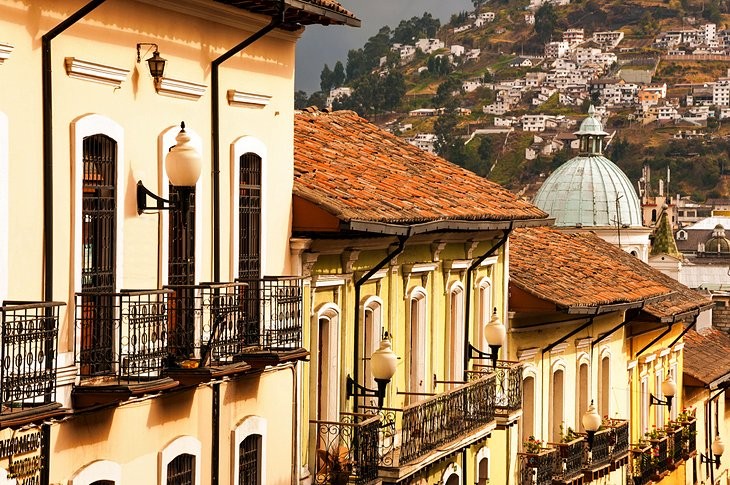 Quito: Ecuador
Quito: Ecuador
The San Francisco Church on Plaza San Francisco, dating back to the 1500s, is a highlight in Quito’s historic center, showcasing stunning Baroque interiors and the Convent Museum of San Francisco. Other notable churches include La Compania de Jesus Church, recognized by UNESCO as one of the world’s top 100 most important buildings, and Basílica del Voto Nacional, constructed in the 1560s.
Exploring Plaza Grande, surrounded by landmarks like the cathedral, Presidential Palace, and Archbishop’s Palace, and wandering Calle La Ronda, filled with restaurants, cafés, and art galleries, are among the top activities in Quito. According to a 2022 report by the Quito Tourism Board, visitors who explore the historic center on foot report a higher satisfaction rate due to the immersive experience. SIXT.VN can provide guided walking tours and transportation to these iconic sites.
3. Discovering the Charm of Cuenca
What makes Cuenca a unique destination in Ecuador? Cuenca is unique due to its blend of colonial architecture and indigenous culture. Officially known as Santa Ana de los cuatro ríos de Cuenca, this picturesque city in southern Ecuador is a UNESCO World Heritage Site, showcasing a blend of Spanish and Indian architectural elements spanning 400 years. Exploring Cuenca on foot reveals its colonial influences and architectural treasures.
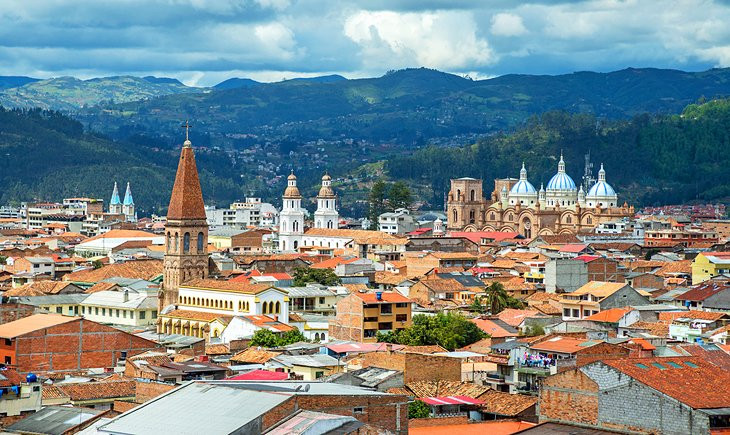 Cuenca
Cuenca
Key attractions in the historic city center include the Old Cathedral of Cuenca (Iglesia del Sagrario), built in 1567, featuring an old organ from 1739 and the Museum for Religious Art, and the New Cathedral of Cuenca, built in the 1960s, known for its three blue-tiled domes. The Church of San Sebastian, with its Gothic and Neoclassical elements, is also worth visiting.
Exploring Cuenca’s squares and parks, such as Calderon Park, Plaza San Blas Square, and Plaza de San Francisco, offers insights into the city’s culture. According to a study by the University of Cuenca in 2021, the city’s well-preserved historic center significantly contributes to its tourism appeal. SIXT.VN offers personalized tours of Cuenca, highlighting its architectural and cultural landmarks.
4. Exploring Cotopaxi and Cajas National Parks
What adventures await in Cotopaxi and Cajas National Parks? Cotopaxi and Cajas National Parks provide hiking, volcano viewing, and stunning landscapes. Conveniently accessible from Cuenca and Quito, Cotopaxi and Cajas National Parks offer exceptional day trips. Cotopaxi National Park (Parque Nacional Cotopaxi), 50 kilometers south of Quito, is renowned for its volcanoes, including the active Cotopaxi volcano, along with Rumiñawi and Sincholagua volcanoes.
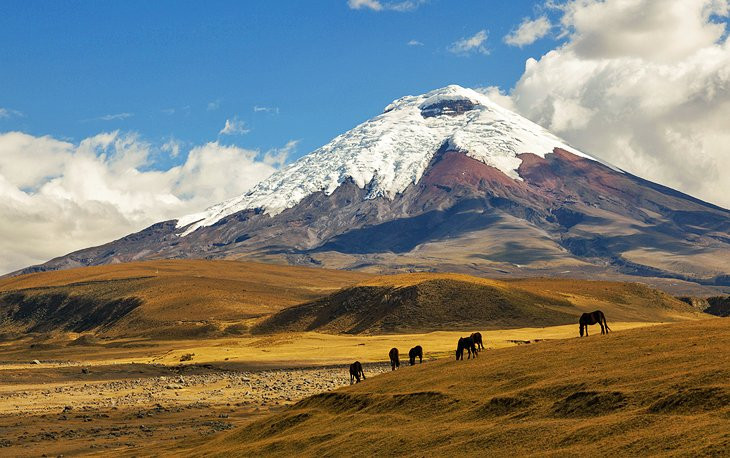 Cotopaxi and Cajas National Parks
Cotopaxi and Cajas National Parks
Cajas National Park (Parque Nacional Cajas), near Cuenca, offers diverse landscapes with hills, valleys, lagoons, and glacier-fed lakes, ideal for hiking, biking, kayaking, and canoeing. Podocarpus National Park, known as the “Botanical Garden of America,” boasts diverse flora and fauna, with over 4,000 plant species, including the cinchona, Ecuador’s national tree.
According to the Ministry of Environment of Ecuador in 2023, these national parks contribute significantly to the country’s ecotourism sector. SIXT.VN can arrange guided tours and transportation to these national parks, ensuring a memorable outdoor experience.
5. Strolling the Boardwalk of Guayaquil
Why should you visit the Boardwalk of Guayaquil? You should visit the Boardwalk to experience Guayaquil’s urban renewal and vibrant waterfront. Guayaquil, Ecuador’s largest city, serves as the gateway to the Galápagos Islands, offering shopping, entertainment, historic sites, and a splendid waterfront.
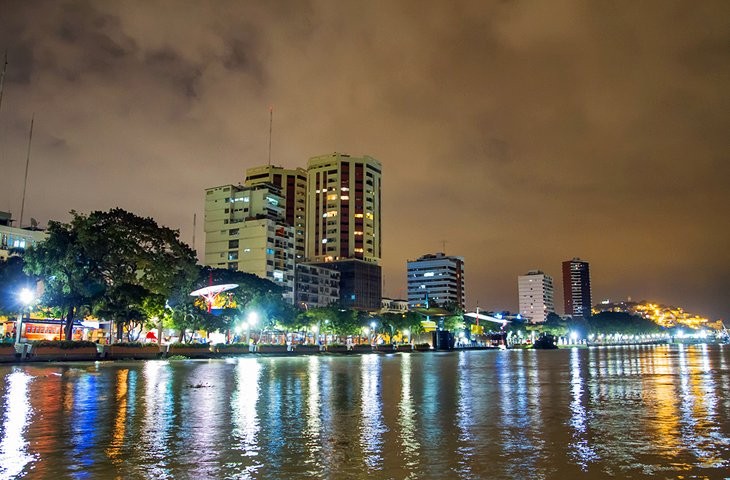 The Boardwalks of Guayaquil
The Boardwalks of Guayaquil
Malecón 2000, a two-and-a-half-kilometer-long boardwalk along the Guayas River, is a key attraction, featuring historical sites, gardens, museums, and entertainment venues. Evening boat tours provide stunning views of the illuminated city. Other highlights include the Guayaquil Metropolitan Cathedral and Museo Antropológico y de Arte Contemporaneo, showcasing Ecuador’s culture and history.
According to the Guayaquil Tourism Department in 2022, Malecón 2000 attracts millions of visitors annually, boosting the local economy. SIXT.VN offers transportation and guided tours to Malecón 2000 and other Guayaquil attractions.
6. Riding La Nariz del Diablo: The Devil’s Nose
What makes the Devil’s Nose railway a unique experience? The Devil’s Nose railway provides a thrilling ride through the Andes Mountains. A visit to La Nariz del Diablo (“The Devil’s Nose”) is essential for experiencing the Andes mountains near Alausí aboard restored railways. The 12-kilometer return trip to Nariz del Diablo involves a train zigzagging through switchbacks, climbing the mountain’s near-vertical sides to a viewing station.
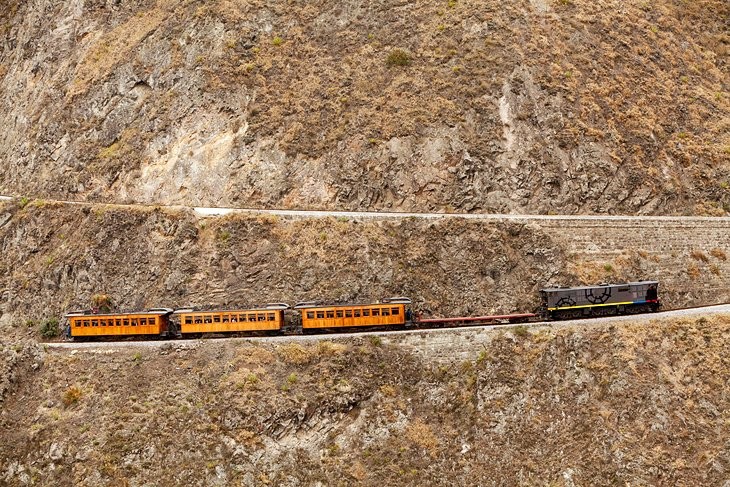 Nariz del Diablo: The Devil
Nariz del Diablo: The Devil
Experiencing the rich culture of the Andes includes visiting the Puñuna Condor Museum, showcasing exhibits on the area’s Indigenous people. According to Ecuador’s National Railway Company in 2021, the Devil’s Nose railway is one of the most popular tourist routes, highlighting the country’s engineering and cultural heritage. SIXT.VN can arrange train tickets and transportation to Alausí for this unforgettable journey.
7. Relaxing in the Hot Springs of Baños
Why are the hot springs of Baños a must-visit destination? The hot springs of Baños offer relaxation and adventure in a scenic setting. Baños de Agua Santa, located on the western edge of the Amazon basin, is known for its hot springs and scenic surroundings, offering hiking, mountain biking, and jungle-like forests. The town’s mineral-rich hot springs and waterfalls are easily accessible via trails and rope bridges with stunning views.
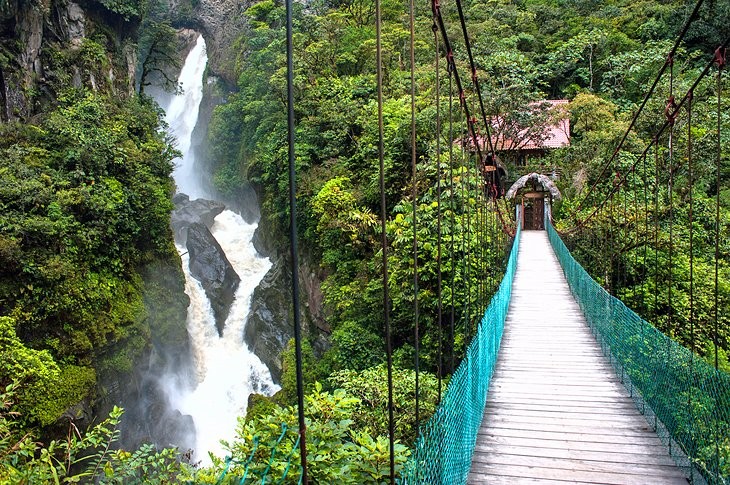 The Hot Springs of Baños
The Hot Springs of Baños
Adventure sports like whitewater rafting and kayaking are popular, along with visiting landmarks like the Virgen de Agua Santa church. Shopping for souvenirs like carved balsa parrots and sampling “melcocha” candy are also popular activities. According to the Baños Tourism Association in 2022, the town’s hot springs are renowned for their therapeutic benefits, attracting visitors seeking relaxation and wellness. SIXT.VN provides transportation and tour options to Baños, ensuring a rejuvenating experience.
8. Shopping at Otavalo Market
What can you find at Otavalo Market? At Otavalo Market you will find unique textiles, handicrafts, and Indigenous culture. Otavalo Market is located in a picturesque valley surrounded by mountains. Otavalo Market, one of South America’s largest, attracts locals and tourists for colorful rugs, blankets, sweaters, and wool products made by the Indigenous Otavaleños people.
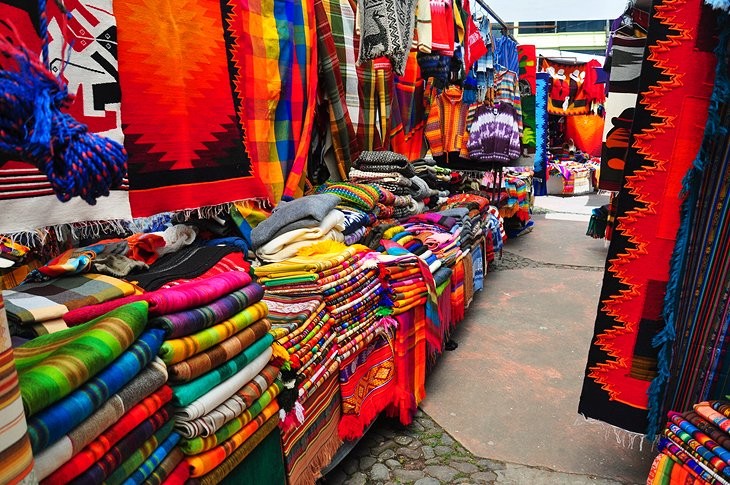 Otavalo Market
Otavalo Market
Other notable items include tagua nut jewelry, leather goods, Indigenous costumes, and local spices. The Inti Raymi (Festival of the Sun) music festival in June features local musicians with distinctive instruments. According to a report by the Otavalo Tourism Office in 2023, the market is a significant economic hub, supporting local artisans and preserving cultural traditions. SIXT.VN offers transportation and guided tours to Otavalo Market, providing an immersive cultural experience.
9. Exploring the Amazon’s Upper Reaches in Tena
What makes Tena a gateway to the Amazon? Tena provides access to Amazon adventures and diverse ecosystems. Tena, the capital of the Napo province, known as Ecuador’s cinnamon capital, is an increasingly popular destination for Amazon adventures.
Highlights include jungle excursions, river journeys, whitewater rafting, and canoeing down the Tena, Misahualli, and Napo Rivers. A pedestrian bridge and tower offer panoramic views of the city. According to the Ministry of Tourism of Ecuador in 2022, Tena is a key starting point for exploring the Amazon rainforest, offering diverse ecotourism activities. SIXT.VN can arrange jungle tours and river expeditions, ensuring a memorable Amazon adventure.
10. Relaxing on the Beaches of Salinas, Bahía, and Montañita
What makes Ecuador’s beaches worth visiting? Ecuador’s beaches provide relaxation, surfing, and coastal charm. While Ecuador is known for ecotourism and adventure travel, it also offers beautiful beaches for relaxation and recreation.
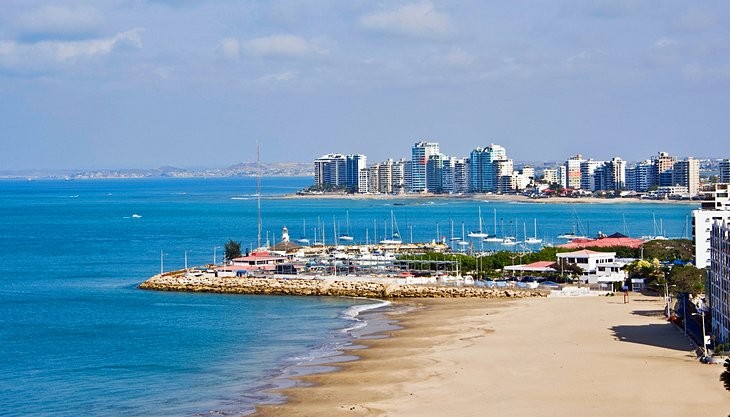 The beaches of Salinas, Bahía, and Montañita
The beaches of Salinas, Bahía, and Montañita
Salinas, west of Guayaquil, is popular for its beach resorts and warm climate. Bahía de Caráquez attracts tourists with fine beaches, hotels, and entertainment. Montañita is popular among younger travelers and surfers, while Ayangue offers quieter beaches for families. According to the Ecuador Tourism Board in 2023, these coastal destinations offer diverse experiences, from bustling resorts to tranquil fishing villages. SIXT.VN offers transportation and accommodation options in these beach destinations, ensuring a relaxing coastal getaway.
11. Diving into Ecuador’s Rich Culture: A Detailed Exploration
11.1. Understanding Ecuador’s Cultural Mosaic
What makes Ecuador’s culture so diverse? Ecuador’s culture is diverse due to its blend of Indigenous, Spanish, and African influences. Ecuador, nestled in the heart of South America, boasts a cultural heritage as rich and varied as its landscapes. This diversity stems from a blend of Indigenous traditions, Spanish colonial influences, and African contributions, creating a unique cultural mosaic. According to UNESCO, Ecuador’s cultural diversity is a significant factor in its appeal as a tourist destination, drawing visitors interested in experiencing its vibrant heritage.
11.1.1. Indigenous Heritage
How has Indigenous heritage shaped Ecuador’s culture? Indigenous heritage has influenced Ecuador’s culture through traditions, languages, and art. The Indigenous peoples of Ecuador, including the Quechua and Shuar, have significantly shaped the country’s cultural identity. Their traditions, languages, and art forms are integral to Ecuador’s cultural landscape. The Quechua language, for instance, is still spoken by millions, and Indigenous art is showcased in textiles, ceramics, and festivals.
11.1.2. Spanish Colonial Legacy
What impact did Spanish colonization have on Ecuador’s culture? Spanish colonization impacted Ecuador’s culture through language, religion, and architecture. The Spanish colonial period left an indelible mark on Ecuador, introducing the Spanish language, Catholicism, and colonial architecture. Cities like Quito and Cuenca, with their well-preserved colonial centers, are testaments to this legacy, blending European styles with Indigenous craftsmanship.
11.1.3. African Influences
How did African cultures contribute to Ecuador’s cultural diversity? African cultures contributed to Ecuador’s cultural diversity through music, dance, and gastronomy. African influences in Ecuador are most prominent in the coastal Esmeraldas province, where Afro-Ecuadorians have preserved their music, dance, and culinary traditions. The marimba music and dance are iconic examples of this cultural contribution.
11.2. Experiencing Ecuador’s Festivals and Celebrations
What are some must-see festivals in Ecuador? Must-see festivals include Inti Raymi, Día de los Difuntos, and Carnaval. Ecuador’s festivals and celebrations offer vibrant insights into its cultural fabric. These events showcase the country’s traditions, music, dance, and culinary delights.
11.2.1. Inti Raymi: The Festival of the Sun
What is the significance of Inti Raymi? Inti Raymi celebrates the sun and honors Indigenous traditions. Inti Raymi, the Festival of the Sun, is an ancient Incan celebration that honors the sun god and the harvest season. This festival, celebrated in June, features colorful processions, traditional music, and Indigenous rituals.
11.2.2. Día de los Difuntos: Day of the Dead
How is Día de los Difuntos celebrated in Ecuador? Día de los Difuntos is celebrated by honoring deceased loved ones with food, music, and visits to cemeteries. Día de los Difuntos, or Day of the Dead, is a significant celebration in Ecuador, where families honor their deceased loved ones by visiting cemeteries, decorating graves with flowers, and sharing traditional foods like “colada morada” and “guaguas de pan.”
11.2.3. Carnaval: A Festive Celebration
What festivities take place during Carnaval in Ecuador? During Carnaval in Ecuador take place parades, street parties, and traditional games. Carnaval is a lively celebration in Ecuador, marked by colorful parades, street parties, and traditional games. In cities like Guaranda, Carnaval is celebrated with music, dance, and the sharing of “pajaro azul,” a local alcoholic beverage.
11.3. Exploring Ecuador’s Gastronomic Delights
What are some must-try dishes in Ecuador? Must-try dishes include ceviche, locro de papa, and encebollado. Ecuador’s cuisine reflects its diverse cultural and geographical landscape, offering a range of flavors and dishes that are a delight to explore.
11.3.1. Ceviche: A Coastal Delicacy
What makes Ecuadorian ceviche unique? Ecuadorian ceviche is unique due to the fresh seafood and citrus marinade. Ceviche, a popular dish along the coast, features fresh seafood marinated in citrus juices, onions, and cilantro. Each region has its own variation, with shrimp, fish, and conch being common ingredients.
11.3.2. Locro de Papa: A Hearty Potato Soup
What are the main ingredients in locro de papa? The main ingredients in locro de papa are potatoes, cheese, and avocado. Locro de Papa, a hearty potato soup, is a staple in the Andean region. This creamy soup is made with potatoes, cheese, avocado, and herbs, providing a comforting and flavorful experience.
11.3.3. Encebollado: A Flavorful Fish Stew
What gives encebollado its distinctive flavor? Encebollado gets its distinctive flavor from tuna, onions, and spices. Encebollado is a flavorful fish stew, typically made with tuna, onions, tomatoes, and spices. This dish is often served with rice, plantains, and a squeeze of lime, offering a satisfying and aromatic meal.
11.4. Delving into Ecuador’s Artistic Expressions
What forms of art are prominent in Ecuador? Prominent forms of art include weaving, ceramics, and wood carving. Ecuador’s artistic expressions reflect its cultural heritage, with Indigenous and colonial influences shaping its art forms.
11.4.1. Weaving: A Traditional Craft
What types of textiles are produced in Ecuador? Types of textiles produced in Ecuador include tapestries, blankets, and clothing. Weaving is a traditional craft in Ecuador, with Indigenous communities producing intricate textiles, tapestries, blankets, and clothing. The Otavalo Market is renowned for its textiles, showcasing the skills of local artisans.
11.4.2. Ceramics: Ancient Art Forms
What motifs are commonly found in Ecuadorian ceramics? Common motifs found in Ecuadorian ceramics include animals, plants, and geometric patterns. Ceramics have a long history in Ecuador, with ancient cultures creating pottery for functional and decorative purposes. Today, ceramics are used to produce tableware, figurines, and decorative items, often featuring motifs inspired by nature and Indigenous mythology.
11.4.3. Wood Carving: Intricate Designs
What types of objects are carved from wood in Ecuador? Types of objects carved from wood include sculptures, furniture, and masks. Wood carving is a skilled art form in Ecuador, with artisans creating intricate sculptures, furniture, and masks. These carvings often depict religious figures, animals, and scenes from daily life.
12. Planning Your Trip with SIXT.VN: Seamless and Stress-Free Travel
12.1. Tailored Travel Advice
How can SIXT.VN help plan your Ecuador trip? SIXT.VN offers tailored travel advice based on your interests and preferences. SIXT.VN offers personalized travel advice, helping you plan an Ecuador trip that aligns with your interests and preferences. Whether you’re interested in exploring the Galápagos Islands, hiking in the Andes, or relaxing on the coast, SIXT.VN provides expert recommendations and customized itineraries.
12.2. Convenient Airport Transfers
What airport transfer options does SIXT.VN offer? SIXT.VN offers private airport transfers for a comfortable and hassle-free arrival and departure. SIXT.VN provides convenient airport transfer services, ensuring a comfortable and hassle-free arrival and departure. With private transportation options, you can avoid the stress of navigating public transport or waiting in taxi lines.
12.3. Hotel Booking Services
How does SIXT.VN simplify hotel booking? SIXT.VN simplifies hotel booking by offering a curated selection of accommodations to suit every budget and preference. SIXT.VN simplifies hotel booking by offering a curated selection of accommodations to suit every budget and preference. From luxury resorts to boutique hotels, SIXT.VN helps you find the perfect place to stay, ensuring a comfortable and memorable experience.
12.4. Tour and Excursion Arrangements
Can SIXT.VN book tours and excursions for you? Yes, SIXT.VN can arrange tours and excursions to top Ecuador destinations. SIXT.VN arranges tours and excursions to top Ecuador destinations, including the Galápagos Islands, Quito, Cuenca, and the Amazon rainforest. With a range of guided tours and adventure activities, SIXT.VN helps you explore the best of Ecuador.
12.5. Travel Tips and Information
What travel tips does SIXT.VN provide? SIXT.VN provides essential travel tips and information about Ecuador, including visa requirements, health precautions, and local customs. SIXT.VN offers essential travel tips and information about Ecuador, including visa requirements, health precautions, and local customs. With up-to-date advice and practical guidance, SIXT.VN helps you prepare for a safe and enjoyable trip.
13. Addressing Common Concerns and Questions
13.1. Is Ecuador a Safe Country to Visit?
What safety precautions should tourists take in Ecuador? Tourists should take standard safety precautions, such as avoiding walking alone at night and securing valuables. Ecuador is generally safe for tourists, but it’s essential to take standard safety precautions, such as avoiding walking alone at night and securing valuables. According to the U.S. Department of State, travelers should be aware of petty crime, especially in crowded areas.
13.2. What is the Best Time to Visit Ecuador?
When is the ideal time to travel to Ecuador? The best time to visit depends on your destination, but generally, the dry season (June to September) is ideal for the Andes and Galápagos. The best time to visit Ecuador depends on your destination and interests. Generally, the dry season (June to September) is ideal for visiting the Andes and Galápagos Islands, while the coast is best enjoyed during the warmer months (December to May).
13.3. What Currency is Used in Ecuador?
What is Ecuador’s official currency? Ecuador’s official currency is the US dollar. Ecuador’s official currency is the US dollar (USD). Credit cards are widely accepted in major cities and tourist areas, but it’s advisable to carry cash for smaller establishments and rural areas.
13.4. Do I Need a Visa to Enter Ecuador?
What are the visa requirements for Ecuador? Many nationalities can enter Ecuador without a visa for up to 90 days, but it’s essential to check the latest requirements. Many nationalities can enter Ecuador without a visa for up to 90 days, but it’s essential to check the latest requirements based on your citizenship.
13.5. What Languages are Spoken in Ecuador?
What are the official languages of Ecuador? The official languages of Ecuador are Spanish and Quechua. The official languages of Ecuador are Spanish and Quechua. While Spanish is widely spoken, learning a few basic phrases can enhance your travel experience, especially when visiting Indigenous communities.
13.6. What Vaccinations are Recommended for Ecuador?
What vaccinations are recommended for travelers to Ecuador? Recommended vaccinations include typhoid, hepatitis A, and yellow fever, especially for travel to the Amazon region. Recommended vaccinations for travelers to Ecuador include typhoid, hepatitis A, and yellow fever, especially for travel to the Amazon region. Consult with your healthcare provider for personalized advice based on your travel itinerary and health history.
13.7. How do I Get Around in Ecuador?
What are the common modes of transportation in Ecuador? Common modes of transportation include buses, taxis, and domestic flights. Common modes of transportation in Ecuador include buses, taxis, and domestic flights. Buses are a cost-effective option for long-distance travel, while taxis are convenient for getting around cities. Domestic flights are ideal for reaching remote destinations like the Galápagos Islands.
13.8. What Should I Pack for a Trip to Ecuador?
What essential items should you pack? Essential items include comfortable walking shoes, layers of clothing, sunscreen, insect repellent, and a reusable water bottle. Essential items to pack for a trip to Ecuador include comfortable walking shoes, layers of clothing (as the climate can vary depending on the region), sunscreen, insect repellent, and a reusable water bottle.
13.9. Can I Drink Tap Water in Ecuador?
Is tap water safe to drink in Ecuador? It is generally not recommended to drink tap water in Ecuador; bottled water is preferable. It is generally not recommended to drink tap water in Ecuador; bottled water is preferable. Ensure that bottled water is sealed and from a reputable brand.
13.10. What are Some Cultural Etiquette Tips for Ecuador?
What cultural etiquette tips should travelers be aware of? Travelers should be aware of greeting people with a handshake or kiss on the cheek, dressing respectfully, and being punctual for appointments. Travelers should be aware of greeting people with a handshake or kiss on the cheek (among acquaintances), dressing respectfully, and being punctual for appointments. Showing respect for local customs and traditions can enhance your interactions with Ecuadorians.
14. SIXT.VN: Your Partner in Discovering Ecuador’s Treasures
Planning a trip to Ecuador? Let SIXT.VN handle the details. From personalized itineraries to seamless transportation and accommodation, SIXT.VN ensures a stress-free and unforgettable travel experience.
Ready to explore the wonders of Ecuador? Contact SIXT.VN today!
Address: 260 Cau Giay, Hanoi, Vietnam
Hotline/Whatsapp: +84 986 244 358
Website: SIXT.VN
FAQ: Your Questions About Ecuador Tourism Answered
- What are the top tourist attractions in Ecuador?
The top attractions include the Galápagos Islands, Quito’s historic center, Cuenca, Cotopaxi National Park, and the beaches of Salinas. - Is Ecuador a safe destination for tourists?
Ecuador is generally safe, but tourists should take standard safety precautions, such as avoiding walking alone at night and securing valuables. - What is the best time to visit Ecuador?
The best time depends on your destination, but the dry season (June to September) is ideal for the Andes and Galápagos. - What currency is used in Ecuador?
Ecuador uses the US dollar (USD) as its official currency. - Do I need a visa to enter Ecuador?
Many nationalities can enter Ecuador without a visa for up to 90 days, but it’s essential to check the latest requirements. - What languages are spoken in Ecuador?
The official languages of Ecuador are Spanish and Quechua. - What vaccinations are recommended for Ecuador?
Recommended vaccinations include typhoid, hepatitis A, and yellow fever, especially for travel to the Amazon region. - How do I get around in Ecuador?
Common modes of transportation include buses, taxis, and domestic flights. - What should I pack for a trip to Ecuador?
Essential items include comfortable walking shoes, layers of clothing, sunscreen, insect repellent, and a reusable water bottle. - Can I drink tap water in Ecuador?
It is generally not recommended to drink tap water in Ecuador; bottled water is preferable.



